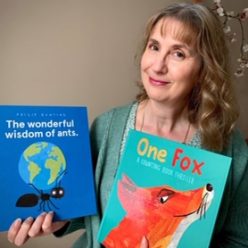Illustrated by Milan Samadder

I have a dear friend who lives in Warrnambool, a regional city on the south-west coast of Victoria in Australia, and who works for a major dairy manufacturer. My friend is one of many hundreds who rely on this industry to provide work and income security for their families. Indeed, the milk I buy comes all the way from Warrnambool to Melbourne, and the cheese and yoghurt too. How it arrives in our local supermarket is not something I think about, but I should. Our resources are precious, our food is important, and we should respect the effort that farmers and growers make to provide for our communities.
This picture book is about Holly the black and white Holstein cow, born and bred in far north Queensland in the care of Farmer Col and his wife. Farmer Col is actually Colin Daley, he runs “Ourway Holsteins” just outside Millaa Millaa in Queensland. Nearby is Mt. Bartle Frere and these places form the backdrop to the story.
If you listen to the audio version, Russell and members of his family provide the voices of all the characters in the book. It’s written in rhyming prose, making it easy to remember while we simultaneously learn about the twice daily milking routine of the cows, the food they eat and where they graze.
One day, Holly is chosen by Farmer Col to go to the local farm show. While she is there, Holly discovers all the varied products that are made using her milk. On display in the dairy cabinets are milk, yoghurt, butter, and cheese. Holly is delighted to see her face on all the items and is proud to be the ambassador for Hollyvale dairy products.
The following day at the show, the judges deem Holly to be the best Holstein cow in the competition. Holly comes home from her adventures with a spring in her step, a medal around her neck and a garland atop her head. She has discovered her worth, her value and her contribution to the wider community.
This picture book is a valuable educational resource for young children, helping them to understand the connection between the food we purchase at supermarkets and markets, and the production of it on farms and agricultural estates.
Most importantly, any profits made from the sale of this picture book will be donated to the NSW Mid Coast Dairy Advancement Group to support the 150 dairy farmers whose livelihoods were devastated by the floods in March 2021.
You can view this picture book on YouTube.
You can also purchase this picture book in a PDF format or as a book, just type in the title online and follow the prompts.
I can recommend this picture book for children 4-8 years and below are more suggestions for picture books which explore the concept of how food is grown and produced:

by Deborah Chancellor
Illustrated by Julia Groves



by Elizabeth Zunon

by Lois Ehlert

by Eric Carle


by Grace Lin

My Lunchbox?
by Chris Butterworth
Illustrated by Lucia Gaggiotti

by Mary McKenna Siddals Illustrated by Ashley Wolff

by Phyllis Alsdurf
Illustrated by Steve Johnson
& Lou Fancher

by Paul Galdone


by Emma Giuliani

by Lucy Cousins

by Gail Gibbons

































































































































